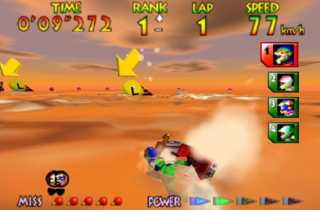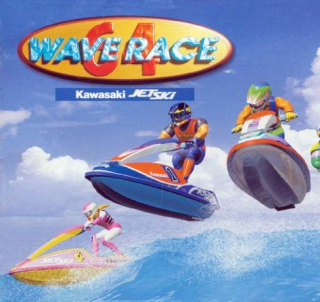Overview

Wave Race 64 is a third-person personal watercraft racing game developed by Nintendo EAD and published by Nintendo for the Nintendo 64 in Japan (on September 27, 1996), in North America (on November 1, 1996), and in Europe (on April 29, 1997).
The sequel to the 1992 Game Boy game Wave Race, Wave Race 64 revamps the original game's racing by adding slalom-based navigation (requiring players to zig-zag around buoys to prevent disqualification), realistic water physics (with water waves affecting PWC movement), and multiple playable characters (each with their own unique stats). It also adds the ability to perform stunts and split-screen two-player multiplayer.
The Japanese version of the game features in-game advertisements for Kawasaki (and their Jet Ski brand of PWC) as well as the Fanta Orange beverage, the latter of which was removed in the International versions. The Japanese version of the game was later re-released in July 1997, supporting the Rumble Pak accessory and adding Time Trial Ghosts while changing some sound effects, dialog, and music. The game later received a sequel for the GameCube in 2001, titled Wave Race: Blue Storm.
The game was later digitally re-released as a Virtual Console title for the Wii (in 2007) and Wii U (in 2015-2016). All Kawasaki, Jet Ski, and Fanta Orange branding was replaced with generic Nintendo hardware branding (with the branding on the PWCs themselves removed entirely). It was later added to the original platform's Nintendo Switch Online service on August 19, 2022.
Gameplay

The race events of Wave Race 64 are standard races to the finish line against three opponents, with a twist. The player has to maneuver their jet ski past buoys, passing each buoy on alternating sides. Passing buoys on the the appropriate side in succession will grant power boosts, increasing speed, but missing one will result in a power-down. The player will earn points at the end of each race dependent on their finishing position, and the racer with the most points at the end of the tournament wins.
The stunt events take place on the same tracks as the races, but this time the only goal is to score as many points as possible by doing tricks off of ramps and going through rings.
Characters & Watercraft
Similar to the original F-Zero, the game includes four riders/watercraft to choose from, each with their own unique stats and playstyle:
- Ryota Hayami, wearing blue and green, is an all-around rider with no real strengths or weaknesses.
- Ayumi Stewart, wearing pink and white, is ideal for beginners, as she has the fastest base acceleration and exceptional base handling. However, she can't handle collisions as well as the others, and has the lowest base maximum speed.
- Miles Jeter, wearing blue and red, is ideal for more intermediate players, as he has the best base handling, at the cost of the worst base grip.
- Dave Mariner, wearing yellow and green, is ideal for more advanced players, as he has the highest base maximum speed and is the most stable during collisions. However, he has the worst base handling, low base grip, and the slowest base acceleration.
In addition, players can tune their watercraft using three sliders: Handling (for how far the control stick needs to be pushed in order to turn), Engine (for determining the ratio between acceleration and maximum speed), and Grip (for determining the ratio between overall speed and "slippery" turning).
Game Modes
Championship
The game's main single-player mode, in which players race on a set number of courses (six in Normal difficulty, seven in Hard, and eight in Expert) against three other computer-controlled racers. Each racer is given points at the end of each race based on their placement (7 for first, 4 for second, 2 for third, 1 for fourth, 0 if disqualified), and players who do not receive a certain amount of overall points between each race gets a game over.
There are three difficulty settings, each increasing the number of courses, course difficulty, opponent speed, and number of points required to proceed. The Hard difficulty is unlocked when completing the Normal difficulty, and completing that will unlock the Expert difficulty.
On Normal difficulty, the game allows players to "Warm Up" on the game's practice course so they can be accustomed to their watercraft.
Time Trial
Players can choose any unlocked course and difficulty and race solo to finish with the quickest possible time. In the Japanese re-release, players can race against recordings (or "ghosts") of the fastest time.
Stunt Mode
Rather than competing for speed, players are instead scored based on their stunt routine (with both aerial spins and on-water tricks), with additional points for going through rings and quickly reaching checkpoints.
2P VS.
Split-screen multiplayer for up to two players, allowing head-to-head races in any unlocked course and difficulty.
Courses

The game includes eight courses, two of which can only be unlocked by completing Championship mode in higher difficulties.
- Sunny Beach - A simple oval circuit with minimal obstacles. Known in Japan as Sandy Beach.
- Sunset Bay - In addition to a more complex circuit layout, Sunset Bay introduces players to ramps.
- Drake Lake - Takes place on a misty lake, Drake Lake has the calmest water of all courses. However, the course contains weeds that hinder speed and a dangerous group of wooden posts. The mist also hinders vision, but clears up as the race progresses. Known in Japan as Milky Lake.
- Marine Fortress - Taking place during a windy storm, Marine Fortress has hectic water and scattered crates. The Hard and Expert difficulties includes a shortcut that opens up as the race progresses.
- Port Blue - The race takes place around a large tanker with one area blocked off, requiring players to detour through the tunnels of the titular industrial port. The Hard difficulty adds an alternate tunnel that is faster, but more difficult to navigate. The Expert difficulty blocks off the original tunnel, requiring players to use the alternate tunnel. Known in Japan as Port Pirate.
- Twilight City (Hard/Expert only) - Includes numerous twists and turns, as well as thin ramps that bypass obstacles. It also includes an alternate shortcut that is only taken by ramp. The Expert difficulty shortens the length of most ramps and alters the shortcut ramp (requiring players to use the ramp's momentum to slide under the wall). Known in Japan as Castle City.
- Glacier Coast (Expert only) - In addition to a difficult buoy layout, Glacier Coast is filled with slippery glaciers, requiring players to use their momentum to slide across them. Known in Japan as Cool Wave.
- Southern Island - Despite its sunny appearance, Southern Island has water that gets most hectic as the race progresses (eventually getting more hectic than that of Marine Fortress). Unlike other courses, the water level drops as the race progresses, making certain ramps unavailable while adding new obstacles.
In addition, the game includes a dedicated area for the game's practice mode. Called Dolphin Park, it features multiple ramps and obstacles to practice with. Both this mode, as well as all unlocked courses, can also be played in Stunt Mode.

 Nintendo 64
Nintendo 64 Wii Shop
Wii Shop Wii U
Wii U



















